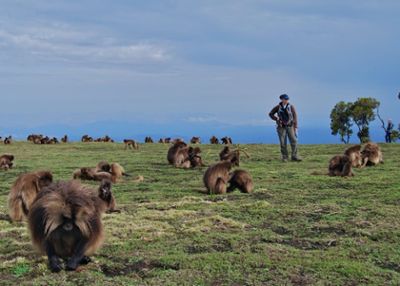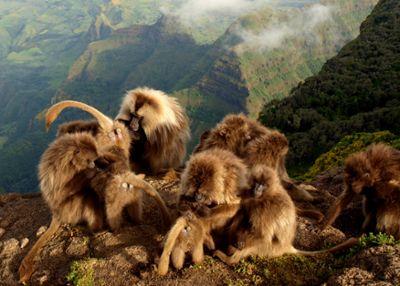How social pressure can shape evolution
Michigan State University’s Elizabeth Tinsley Johnson grew up near New York City, fascinated by its social landscape. There were so many people coexisting in relative harmony; simultaneously navigating the city streets, subways lines and a diversity of complex relationships including friends, family, and even strangers.

Although some of those experiences are unique to New York, navigating social complexities is a challenge shared by people everywhere. In fact, it’s a challenge that extends beyond humanity. Tinsley Johnson, assistant professor of integrative biology in the MSU College of Natural Science, studies how the behavior of social creatures — primates, in particular — has evolved.
“There is an interaction between biology, development, and behavior. Natural selection can shape a behavior just like it can a physical trait,” said Tinsley Johnson, who is the first author of a new study, published earlier this month in the journal Proceedings of the Royal Society B.
“When we think about why humans evolved to be so smart – or why any animal evolved to be so smart – we could argue that it is either because they have a complicated environment (where it’s hard to find food or to stay alive) or a complicated social life. It’s often thought of as an either-or,” she said. “What this study shows is that you can’t pull those things apart. They are intertwined.”
Tinsley Johnson and collaborators at the University of Michigan, Arizona State University and Stony Brook University in New York, studied a monkey species known as geladas in Ethiopia’s Simien Mountain National Park for 14 years.
Here, geladas live in large bands with about 100 individuals, which helps protect them from predators. The geladas primarily eat grass, which is abundant enough that the monkeys don’t usually need to compete over it. If this were the full story, it might seem that geladas have adapted to their environment to live a pretty comfortable existence. But it’s more complicated than that.
Large gelada bands are made up of many smaller, independent groups or units (so independent, in fact, that other researchers have shown that males from different units within the same band don’t recognize each other's calls). What Tinsley Johnson and her colleagues discovered in their 14 years of observation is that there is an ideal group size for females and their young.

If the unit is too small — 4 or fewer adult monkeys — the mortality rate for its females and infants is higher. And if the group is too large — more than about 8 adult monkeys — the infant mortality rate is also likely to be higher. The not-too-big, not-too-small group size appears to be in the middle, at about 6 geladas.
“We’re not saying certain groups do better,” Tinsley Johnson said. “But individuals in a group do better when the group is a certain size.”
For example, females in small groups are most likely to die, which may be related to smaller units being forced into less desirable areas occupied by the gelada band. These areas may have less food, a greater vulnerability to predators, or both. In addition, females in both large and small groups are more likely to lose their infants to infanticide (specifically, adult males kill infants in a group) than are females in medium-sized groups.
To state the obvious, this behavior is abhorrent to humans. Even studying its evolutionary origins in other animals was largely considered taboo until fairly recently. But researchers have learned that this behavior is not uncommon in the animal kingdom, especially in primates (and, of course, saying a behavior is adaptive or evolved does not imply it is moral).
For the geladas, the behavior appears to be tied to their social dynamics. In a typical gelada group, there are several females and one dominant male. That male is the father of the group’s young. But there are also bachelor groups, groups whose members are exclusively males. And bachelor males can challenge the dominant males in other established units to take their place, which is called a “takeover”. If the challenger is successful and takes over a group, he is likely to kill some of the defeated male’s infants.
For a female, this is obviously costly: they lose their infant and the time and energy invested in it. But because females return to fertility quickly after losing an infant, for a new dominant male infanticide may result in more opportunities to mate and pass on his genes. This is especially true in small groups, where there are only a couple adult females to mate with.
Large groups, where there are more females to maximize a bachelor male’s opportunities to reproduce, are attractive targets for takeovers and experience them frequently. Smaller groups, in contrast, rarely experience takeovers but, when they do, they often result in infanticide. In the medium-sized units, it appears that the numbers offer better odds of protecting against infanticide, while being small enough as to not attract frequent challenges from the bachelors.
“Overall, our study findings show that optimal group size could actually be linked to infanticide risk as well as predation,” says co-author Amy Lu, an assistant professor of anthropology at Stony Brook University. “This has implications for a whole suite of group-living animals, such as other primates and lions, where infanticide may be a risk factor for female fitness and infant survival.”
Fortunately for female geladas, unit size is dynamic, and the new research suggests that female geladas may have options to improve the outlook for themselves and their young.
“The next thing that we’re excited to look at is what females can do,” Tinsley Johnson said. “They’re not doomed to live all of their lives in groups of a static size.”
“Although it’s difficult for small groups to increase their group size to a more optimal size, large gelada groups sometimes split into two or more smaller groups,” says co-first-author Jacob Feder, who is a Ph.D. candidate at Stony Brook University. “By getting closer to the optimal group size, these females could improve their lot in life. But, splitting apart means severing social bonds, so females have to carefully choose who to stay with and who to part ways with.”
“The social group is really just another aspect of the environment that individuals have to navigate — just like they have to solve the challenges of finding food and water, or avoiding predators,” Tinsley Johnson said. “Social dynamics are layered on top of that and also shape fitness in important ways.”
Banner image: Geladas socializing in Ethiopia’s Simien Mountains National Park. Credit: Shayna Lieberman